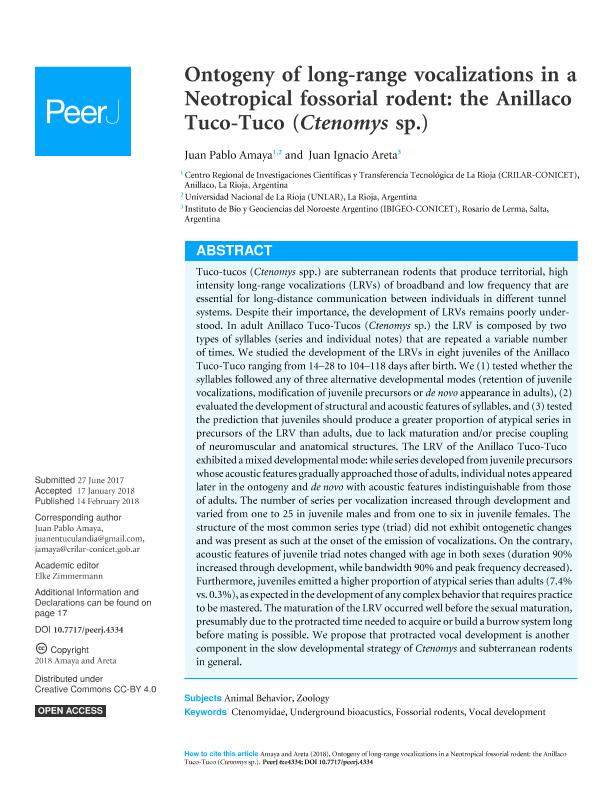Mostrar el registro sencillo del ítem
dc.contributor.author
Amaya, Juan Pablo

dc.contributor.author
Areta, Juan Ignacio

dc.date.available
2019-11-14T17:25:47Z
dc.date.issued
2018-02
dc.identifier.citation
Amaya, Juan Pablo; Areta, Juan Ignacio; Ontogeny of long-range vocalizations in a Neotropical fossorial rodent: The Anillaco Tuco-Tuco (Ctenomys sp.); PeerJ Inc.; PeerJ; 2018; 2; 2-2018
dc.identifier.issn
2167-8359
dc.identifier.uri
http://hdl.handle.net/11336/88878
dc.description.abstract
Tuco-tucos (Ctenomys spp.) are subterranean rodents that produce territorial, high intensity long-range vocalizations (LRVs) of broadband and low frequency that are essential for long-distance communication between individuals in different tunnel systems. Despite their importance, the development of LRVs remains poorly understood. In adult Anillaco Tuco-Tucos (Ctenomys sp.) the LRV is composed by two types of syllables (series and individual notes) that are repeated a variable number of times. We studied the development of the LRVs in eight juveniles of the Anillaco Tuco-Tuco ranging from 14-s28 to 104-118 days after birth. We (1) tested whether the syllables followed any of three alternative developmental modes (retention of juvenile vocalizations, modification of juvenile precursors or de novo appearance in adults), (2) evaluated the development of structural and acoustic features of syllables, and (3) tested the prediction that juveniles should produce a greater proportion of atypical series in precursors of the LRV than adults, due to lack maturation and/or precise coupling of neuromuscular and anatomical structures. The LRV of the Anillaco Tuco-Tuco exhibited a mixed developmental mode: while series developed from juvenile precursors whose acoustic features gradually approached those of adults, individual notes appeared later in the ontogeny and de novo with acoustic features indistinguishable from those of adults. The number of series per vocalization increased through development and varied from one to 25 in juvenile males and from one to six in juvenile females. The structure of the most common series type (triad) did not exhibit ontogenetic changes and was present as such at the onset of the emission of vocalizations. On the contrary, acoustic features of juvenile triad notes changed with age in both sexes (duration 90% increased through development, while bandwidth 90% and peak frequency decreased). Furthermore, juveniles emitted a higher proportion of atypical series than adults (7.4% vs. 0.3%), as expected in the development of any complex behavior that requires practice to be mastered. The maturation of the LRV occurred well before the sexual maturation, presumably due to the protracted time needed to acquire or build a burrow system long before mating is possible. We propose that protracted vocal development is another component in the slow developmental strategy of Ctenomys and subterranean rodents in general.
dc.format
application/pdf
dc.language.iso
eng
dc.publisher
PeerJ Inc.
dc.rights
info:eu-repo/semantics/openAccess
dc.rights.uri
https://creativecommons.org/licenses/by-nc-sa/2.5/ar/
dc.subject
CTENOMYIDAE
dc.subject
FOSSORIAL RODENTS
dc.subject
UNDERGROUND BIOACUSTICS
dc.subject
VOCAL DEVELOPMENT
dc.subject.classification
Zoología, Ornitología, Entomología, Etología

dc.subject.classification
Ciencias Biológicas

dc.subject.classification
CIENCIAS NATURALES Y EXACTAS

dc.title
Ontogeny of long-range vocalizations in a Neotropical fossorial rodent: The Anillaco Tuco-Tuco (Ctenomys sp.)
dc.type
info:eu-repo/semantics/article
dc.type
info:ar-repo/semantics/artículo
dc.type
info:eu-repo/semantics/publishedVersion
dc.date.updated
2019-10-18T18:11:54Z
dc.journal.volume
2018
dc.journal.number
2
dc.journal.pais
Reino Unido

dc.journal.ciudad
London
dc.description.fil
Fil: Amaya, Juan Pablo. Universidad Nacional de La Rioja; Argentina. Consejo Nacional de Investigaciones Científicas y Técnicas. Centro Regional de Investigaciones Científicas y Transferencia Tecnológica de La Rioja. - Universidad Nacional de La Rioja. Centro Regional de Investigaciones Científicas y Transferencia Tecnológica de La Rioja. - Universidad Nacional de Catamarca. Centro Regional de Investigaciones Científicas y Transferencia Tecnológica de La Rioja. - Secretaría de Industria y Minería. Servicio Geológico Minero Argentino. Centro Regional de Investigaciones Científicas y Transferencia Tecnológica de La Rioja. - Provincia de La Rioja. Centro Regional de Investigaciones Científicas y Transferencia Tecnológica de La Rioja; Argentina
dc.description.fil
Fil: Areta, Juan Ignacio. Consejo Nacional de Investigaciones Científicas y Técnicas. Centro Científico Tecnológico Conicet - Salta. Instituto de Bio y Geociencias del NOA. Universidad Nacional de Salta. Facultad de Ciencias Naturales. Museo de Ciencias Naturales. Instituto de Bio y Geociencias del NOA; Argentina
dc.journal.title
PeerJ
dc.relation.alternativeid
info:eu-repo/semantics/altIdentifier/url/https://peerj.com/articles/4334
dc.relation.alternativeid
info:eu-repo/semantics/altIdentifier/doi/https://doi.org/10.7717/peerj.4334
Archivos asociados
